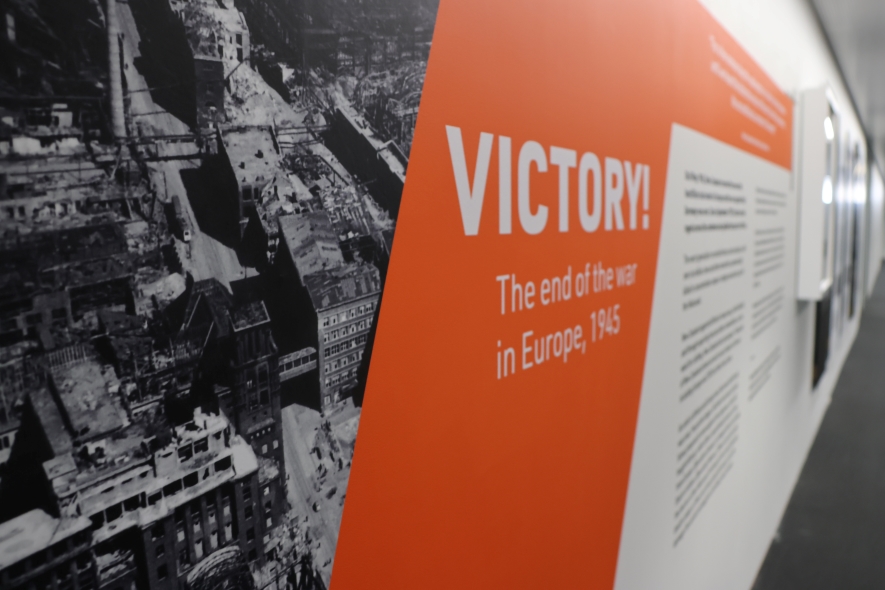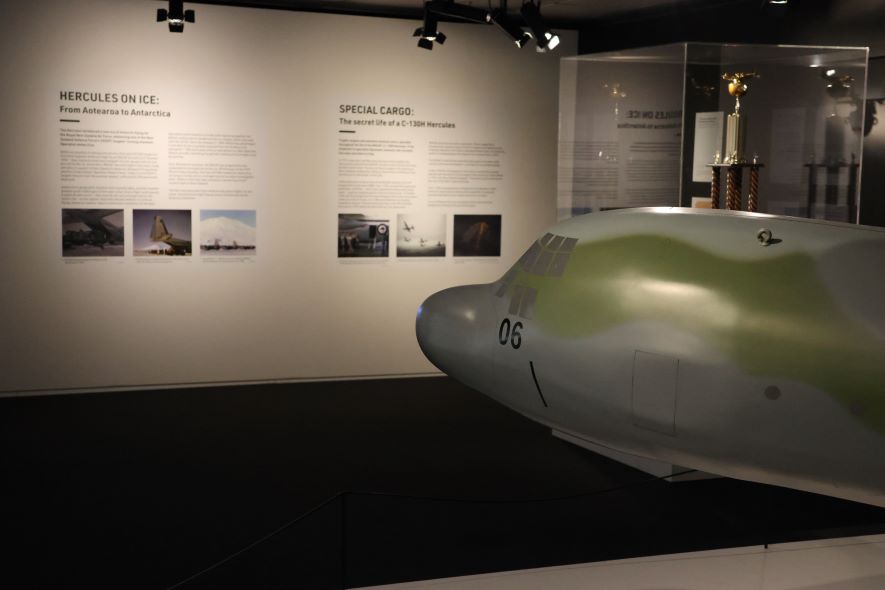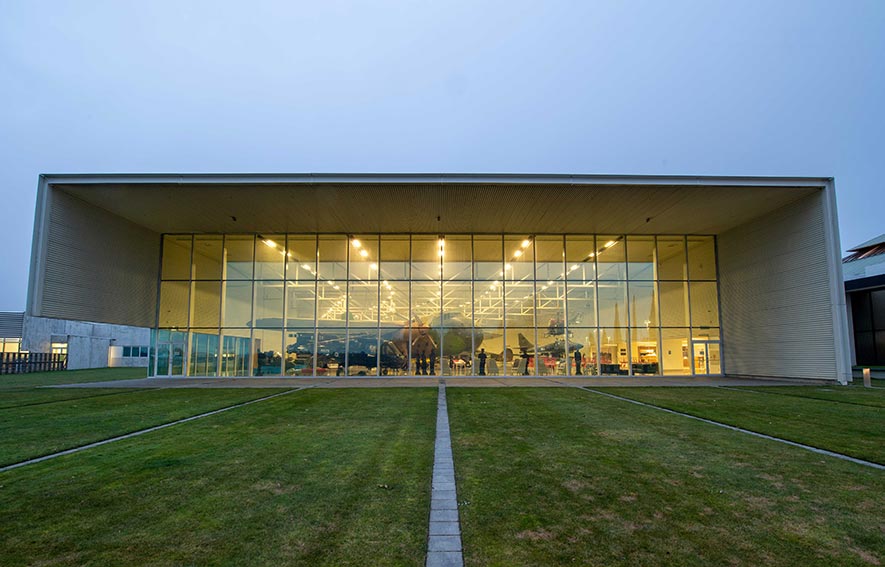What's on at Air Force Museum of New Zealand
Latest from the museum

Latest Exhibition
Victory!
Exhibition
The Mighty Hercules

Update
Overseas visitor charge

Our Aircraft
Explore AircraftMore to explore

Latest Exhibition
Exhibition

Update

More to explore
MYSTERY AIRCRAFT AND SHIP COMPETITION: This week's puzzle is so difficult it comes with a health warning.
Your job is to name the RNZAF aircraft (not the hardest) towing the drogue AND the ship below (which, just quietly, might just be impossible!).
Put your answers in the comments below. If you prefer a confidential service email communications@airforcemuseum.co.nz.
Correct entries will go in the draw to win an Air Force Museum of New Zealand guaranteed authentic roundel mug. They're not only round, they come with roundels!
HEALTH WARNING: The Air Force Museum of New Zealand takes no responsibility for any eye strain injuries or accidents with magnifying glasses sustained in the course of identifying the ship in this competition.
Go#mysteryaircraftr#rnznr#RNZAFnzn #rnzaf ... See MoreSee Less
Comment on Facebook
DC-3 and a Leander class frigate. Possibly HMNZS Otago or Waikato. Mmmmm.
Dak 3546 and Otago. Be amazing if that was the flight I was flying and they hit the cable halfway to the drone.
Love a good challenge! That’s a Dakota in the air and… was thinking Taranaki or Otago, but… I’m going with Blackpool on account of the blurred pennant number looks like two digits to my admittedly tiring eyes…
Naming the plane is easy - I name it Cyril. The ship is more difficult - not even half a clue.
DC3 and either HMNZS Otago or Taranaki. Im gonna say Otago though
Was this part of finbar exercises?
Dakota 46 drogue towing for NZ Navy frigate.
Douglas type 3 And Cher is riding the deck Cannon of otargo And Katy peri is I fogot
C47 Dakota and HMNZS Taranaki. Its a Rothesay Class Frigate, without the helicopter deck the Leanders had. The code letters on the stern appear to have an A in them, so not Otago.
HMNZS Southland did not have 4,5 inch turrent. Ship is a Rothesay class frigate of which both Otago and Taranaki were.
DC3 and HMNZS Taranaki or Otago but pretty sure Taranaki
DC-3 NZ3546 of 42 Squadron with HMNZS Taranaki F148 (a Type 12 Rothesay class frigate) or HMNZS Otago F111 of the same class. Definitely not a Leander - I served on three of the four we had.
The ship is a Leander Class frigate, so possibly HMNZS Canterbury (F421). The aircraft is a C-47 (DC-3) Dakota.
Based on a photo I have I'd say DC3 and HMNZS otago
C-47 Dakota NZ3546, 42 Squadron. HMNZS Taranaki F148 or HMNZS Otago F111.
Dakota-DC3-C47, HMNZS Royalist.
NZ sending it's latest anti shipping asset to check out the recent Chinese Navy visit?
DC 3 from Ohakea, if I remember correctly it is Tail Number 47- Nod
DC-3 and Otago post the 79 refit
42 Sqn drogue aircraft was NZ3546 & the only airframe with that capabilty having had mods to accomplish this... correct military terminology really for the aircraft is a C47.
Dc3 and Leander class frigate
I'll chuck a curve ball in to the mix. Douglas C-47 Skytrain (the military designation for the DC3) and the frigate is, I believe, HMNZS Blackpool. (F77)
DC3, and going by the shape, a Leander class frigate. Take your pick from HMNZS Waikato, Canterbury, Southland, or Wellington.
DC3 and Rothesay class Frigate - HMNZS Taranaki. Identified by the box like structures either side of the forward part of bridge.
Bruce Cooke Where do you see the transom numbers in that photo? Could be Blackpool, Taranaki or Otago
View more comments
YOU CAN'T PARK THERE MATE: Today's entry from the parking mishap file dates back to 1939.
A Fairey Gordon K4002 (later NZ612), from No. 1 Service Flying Training School, has ended up in a Canterbury ditch after running a bit long at RNZAF Station Wigram. Although it looks like it might buff out and the trainee pilot was likely fine, the Gordon was written off following this parking incident.
The Fairey Gordon (I & II) were light bombers retired from the Royal Air Force and repurposed as RNZAF trainers between 1939 and 1943.
The Gordons were a bit tired when they arrived and, although they were handy trainers, they needed a lot of maintenance and had ongoing engine issues.
They were superceded by the North American Harvards which began arriving at Wigram in June 1941.
#youcantparktheremate #faireygordon #rnzafpastandpresent ... See MoreSee Less
Comment on Facebook
Looks(going by the hangars visible far left) like it's "parked" beside Vickeries road....probably across the road where my wife works!
Has anybody got a copy of the photo showing a Vampire parked on the back of a council truck in the Santof forrest.
Imagine going from one of these to a Harvard. Technological development in the 1930s and 40s was staggering.
It looks like an ideal spot for a nap to me. Very form-fitting.
TRIPLE THREAT: Here's a lovely photo to start the day.
Way back in 1984 we teamed up with the Australian and United States air forces for an exercise called TRIAD84.
Three countries’ strike aircraft are pictured in formation near RNZAF Base Ohakea.
From top; USAF F16 81706, No. 75 Squadron Skyhawk NZ6205, RAAF Mirage A3-54.
This image and many thosands more can be found online at fotoweb.airforcemuseum.co.nz/fotoweb/
#skyhawk #raaf #usaf #f16 #ohakeaairbase #rnzaf #rnzafpastandpresent ... See MoreSee Less
Comment on Facebook
I remember lying on the roof of my house in Auckland watching the F15s flying and manouvering overhead instead of studying for my exams!
Now you see 'em - now you don't . That F-16 would still look great with a Kiwi roundel on its wing .
OMG.!! THANK YOU so much for posting this photo. This has solved a 41yr mystery for me!... i have a memory of two aircraft flying very low over my school during soccer practice...and being a very keen aircraft enthusiast i saw these and realised they were not RNZAF aircraft...but could not place them (too low and too fast). Since then i have often thought about that afternoon and whether i actually saw what i thought i saw.... so there you go, they were two RAAF mirages! The relief😆😆😆
Do it again with today's....oh, never mind.
One of those F16s took the top off a fence post while landing a bit low on approach at Ohakea. The broken piece complete with barbed wire attached was mounted and presented to the pilot in the Officers Mess.
Skyhawk looks like a hot rod of a plane
And what have we got now.?
Remember working in the Taranaki back country middle 70’s and seeing the Skyhawks doing low practice runs, made you proud to be a kiwi.
Send the F 16 s back to NZ now 🤷🏻♂️
That F16 looks great in RNZAF colours. I see a new model coming.
I remember being at primary school watching the F-15 fly out of Whenuapai .
Wow I didn't think those F15s could fly slow enough to keep pace with our 1960s skyhawks
Bring back fighter jets to Ohakea. Was awsome seeing the skyhawks as a young fella. The strike master air mackies were pretty cool too
I remember watching F15 Eagles operating out of Whenuapai during that exercise in 84
Poor old Blunty got left behind
A fantastic time. I remember the big BBQ in 3 Sqns hangar and chatting to a young F15 pilot about where to go for a run. Sgt Probes Probert scored an awesome ride in the back of an F15 as a thank you for looking after the USAF NCOs
Warwick Otang Snow everything get left behind that mirage if he gives it full berries
Yessss! I recall this vaguely, however I had read over the years since then as well that our pilots in the Skyhawks gave those f16 pilots a really good go n even out did them in dog fighting. Could only imagine how more awesome our pilots would have been had we got those F16 s! Man I'm sure, like they did with the Skyhawks would have lasted due to the kiwi military no how and make the best of what u have.
One of my fondest memories as a kid was when 4 F16 (that were in NZ for Triad) flew over my house. Then they did a circuit around Wellington. Was amazing to see them.
I remember that day on Sunday morning the roaring jet engines over Auckland.
Actually the Strike Aircraft for the RAAF back then was the F-111: the Mirage was a fighter.
Them are the days the golden years
1 Mirage 1 F16
I was flying out to Gt Barrier in the 70s when a Skyhawk pulled up beside us, we were in our home built, Minicab cruising along at 120knt and he was almost at stall speed. He said he was going to Whangarei heads across to Dargavill and would be back in Auckland in 15 mins, he then lifted his flaps and powered off and disappeared from sight, within 30 seconds. It was an amazing experience
Very cool. Thanks for posting.
View more comments